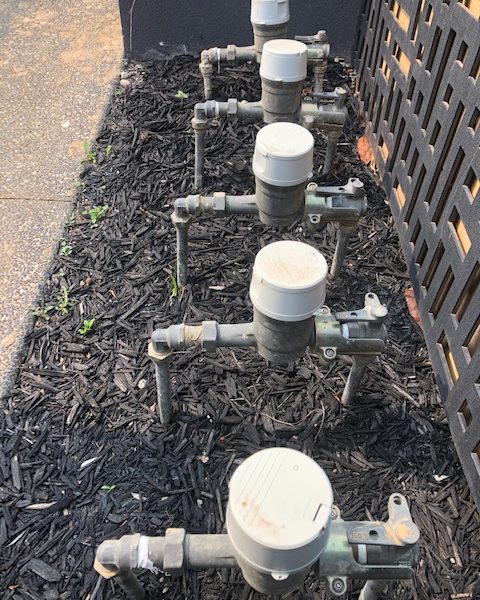When a pipe bursts, a tap breaks or a toilet won’t stop running it can quickly soak or even flood your bathroom if the water isn’t shut off quickly. So, to minimise the damages to your property in the event of a plumbing emergency, you and anyone else in your household should know how to shut off your water supply.
While your mains water valve should be well located and labelled with a council plate, it can still be tricky to find in the dark if you’re not 100% sure what you’re looking for. So, to help you stay prepared for unexpected plumbing disasters, today we will provide a guide to help you locate and operate your water valves.
Why It's Important to Know How to Shut Off Your Water Supply
Sometimes, when leaks or burst pipes occur they can let water into your house in quantities and speeds that your drains, buckets and towels can’t handle alone for long. And when they overflow the water (especially if it’s sewage water) can cause significant and costly structural water damage to your furnishings, floor, walls and ceiling or even pose serious health hazards.
However, by shutting off the water as soon as you notice an issue you can minimise the amount of water that flows through your damaged pipe, tap or toilet and into your house. This will make the plumbing issue more manageable so you can mop up the initial water quickly and protect your house and furniture from damage as well as reduce your contact with potentially contaminated sewage water.
Types of Water Supply Shut-Off Valves
Most properties will have two main kinds of water supply shut-off valves: the mains shut-off valve (or isolation valve for apartments) and individual shut-off valves on plumbing fixtures. It’s important to know the location of and how to operate all of them in the case of plumbing failure or emergencies.
The mains shut-off valve is most important as it stops the flow of all water onto your property and to your fixtures. This should be your first port of call when you notice a leak or burst pipe. If you live in a detached house your mains shut-off valve will be located on your water metre at the front of your property and will generally be covered with a protective council plate. However, if you live in an apartment you would instead be looking for the isolation valve which is generally under the laundry or kitchen sink depending on the layout.
Individual fixture shut-off valves will be located near each of your internal plumbing fixtures, such as sinks, toilets, dishwashers and washing machines. Sink shut-off valves will generally be located under the sink inside the cabinet (if there is one) on the pipes. For toilets, the shut-off valve will generally be located behind the base near the floor or inside the tank under the lid.
Finally, the shut-off valves for electrical appliances such as washing machines and dishwashers will generally be on the hose or pipe that supplies water to the appliance and so will generally be located behind them or in the cabinetry beside them.
Instructions to Shut Off the Water Supply
Once you have located the valve –mains, isolation or individual– you will need to turn the attached valve which could be a lever, knob or handle depending on the fixture until the water is shut off. On the mains, this generally requires turning the lever 90 degrees to the metre, whereas for other valves you may need to turn them clockwise as far as they will go.
If the valve is too tight to turn with your bare hands, you may need to use gloves or a plier or wrench to loosen and turn it. You can then check that the water is fully off by carefully releasing pressure and checking for water flow at an outdoor tap or the fixture in question if switching off an individual or isolation valve.
What to Do After Shutting Off the Water
Once you have confidently shut off the water supply to your property your next step should be to go back inside and check for any leaks. With the flow temporarily stopped, you will now have a little time to take a breath and make a call to your local emergency plumber. If it’s possible to complete some simple, temporary repairs such as taping up the burst pipe or hose, you can do this while you wait for the plumbers to arrive.
If you encounter a plumbing emergency, our experienced team in Essendon can help! Our emergency plumbers are on-call 24/7, 365 days a year and will be able to get to you within an hour if disaster strikes. We are able to accurately diagnose plumbing issues and complete the required repairs so you can restore your water supply sooner without costly damages or lengthy disruptions to your routine.
Protect Your Property and Prevent Costly Water Damage
Don’t let plumbing disasters cause extensive and costly water damage. Take some time now to familiarise yourself and your household with the location of your water supply shut-off valves and make sure everyone knows how to operate them in the case of an emergency.
And remember, that as soon as your water is off, your first call should be to a trusted local emergency plumber, like our team at Essendon Plumbing Services. Quick actions and timely repairs can help to minimise stress and prevent structural damage.


 Professional Roof and Gutter Repairs and Replacement to Stop Leaks
Professional Roof and Gutter Repairs and Replacement to Stop Leaks

